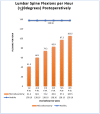Application of Wearable Sensors Technology for Lumbar Spine Kinematic Measurements during Daily Activities following Microdiscectomy Due to Severe Sciatica
- PMID: 35336772
- PMCID: PMC8945562
- DOI: 10.3390/biology11030398
Application of Wearable Sensors Technology for Lumbar Spine Kinematic Measurements during Daily Activities following Microdiscectomy Due to Severe Sciatica
Abstract
Background: The recurrence rate of lumbar spine microdiscectomies (rLSMs) is estimated to be 5-15%. Lumbar spine flexion (LSF) of more than 10° is mentioned as the most harmful load to the intervertebral disc that could lead to recurrence during the first six postoperative weeks. The purpose of this study is to quantify LSFs, following LSM, at the period of six weeks postoperatively.
Methods: LSFs were recorded during the daily activities of 69 subjects for 24 h twice per week, using Inertial Measurement Units (IMU).
Results: The mean number of more than 10 degrees of LSFs per hour were: 41.3/h during the 1st postoperative week (P.W.) (29.9% healthy subjects-H.S.), 2nd P.W. 60.1/h (43.5% H.S.), 3rd P.W. 74.2/h (53.7% H.S.), 4th P.W. 82.9/h (60% H.S.), 5th P.W. 97.3/h (70.4% H.S.) and 6th P.W. 105.5/h (76.4% H.S.).
Conclusions: LSFs constitute important risk factors for rLDH. Our study records the lumbar spine kinematic pattern of such patients for the first time during their daily activities. Patients' data report less sagittal plane movements than healthy subjects. In vitro studies should be carried out, replicating our results to identify if such a kinematic pattern could cause rLDH. Furthermore, IMU biofeedback capabilities could protect patients from such harmful movements.
Keywords: IMU technology; lumbar microdiscectomy; lumbar spine biomechanics; spine biomechanics; wearable sensors.
Conflict of interest statement
The authors declare no conflict of interest.
Figures












Similar articles
-
Preoperative estimation of disc herniation recurrence after microdiscectomy: predictive value of a multivariate model based on radiographic parameters.Spine J. 2017 Mar;17(3):390-400. doi: 10.1016/j.spinee.2016.10.011. Epub 2016 Oct 17. Spine J. 2017. PMID: 27765709
-
Quantifying lumbar sagittal plane kinematics using a wrist-worn inertial measurement unit.Front Sports Act Living. 2024 May 14;6:1381020. doi: 10.3389/fspor.2024.1381020. eCollection 2024. Front Sports Act Living. 2024. PMID: 38807615 Free PMC article.
-
Microdiscectomy compared with transforaminal epidural steroid injection for persistent radicular pain caused by prolapsed intervertebral disc: the NERVES RCT.Health Technol Assess. 2021 Apr;25(24):1-86. doi: 10.3310/hta25240. Health Technol Assess. 2021. PMID: 33845941 Free PMC article. Clinical Trial.
-
Loads distributed in vivo among vertebrae, muscles, spinal ligaments, and intervertebral discs in a passively flexed lumbar spine.Biomech Model Mechanobiol. 2020 Dec;19(6):2015-2047. doi: 10.1007/s10237-020-01322-7. Epub 2020 Apr 20. Biomech Model Mechanobiol. 2020. PMID: 32314072
-
Measurement of lumbar spine intervertebral motion in the sagittal plane using videofluoroscopy.J Back Musculoskelet Rehabil. 2016 Aug 10;29(3):445-57. doi: 10.3233/BMR-150639. J Back Musculoskelet Rehabil. 2016. PMID: 26444329
Cited by
-
Optical Devices for the Diagnosis and Management of Spinal Cord Injuries: A Review.Biosensors (Basel). 2024 Jun 5;14(6):296. doi: 10.3390/bios14060296. Biosensors (Basel). 2024. PMID: 38920599 Free PMC article. Review.
-
Lumbar Kinematics Assessment of Patients with Chronic Low Back Pain in Three Bridge Tests Using Miniaturized Sensors.Bioengineering (Basel). 2023 Mar 8;10(3):339. doi: 10.3390/bioengineering10030339. Bioengineering (Basel). 2023. PMID: 36978730 Free PMC article.
-
Review Article: Diagnostic Paradigm Shift in Spine Surgery.Diagnostics (Basel). 2025 Feb 28;15(5):594. doi: 10.3390/diagnostics15050594. Diagnostics (Basel). 2025. PMID: 40075840 Free PMC article. Review.
-
Physical Activity and Ecological Means of Transport-Functional Assessment Methodology.Int J Environ Res Public Health. 2022 Jul 28;19(15):9211. doi: 10.3390/ijerph19159211. Int J Environ Res Public Health. 2022. PMID: 35954567 Free PMC article.
References
LinkOut - more resources
Full Text Sources

